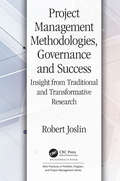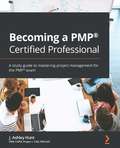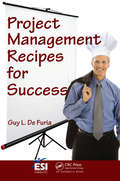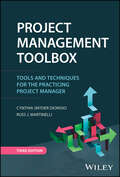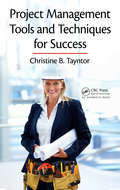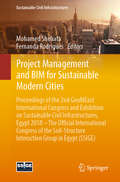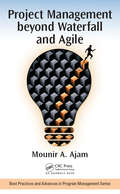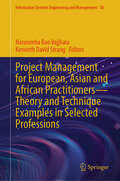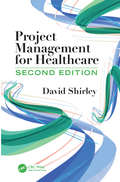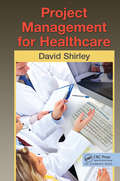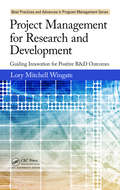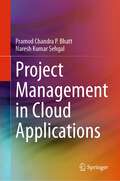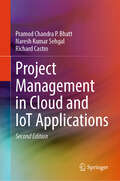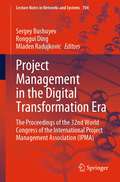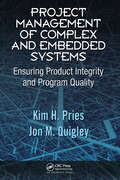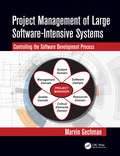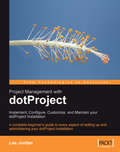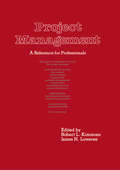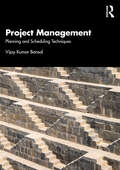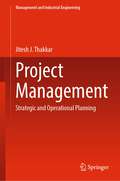- Table View
- List View
Project Management Methodologies, Governance and Success: Insight from Traditional and Transformative Research (Best Practices and Advances in Program Management)
by Robert JoslinProject management methodologies, practices, and guidelines are the only explicit information that project managers have and, when properly maintained, should reflect the most current knowledge and guidance to achieve repeatable successful project outcomes. Despite more than 50 years of research in the field of project management, project success r
Project Management Professional (PMP)® Certification Study Guide
by J. Ashley HuntThis book is for experienced project managers looking for a common language and best practices in the project management space who wish to gain certification and improve their career growth potential. A minimum of 5 to 7 years of experience in leading and directing projects in a variety of industries will be useful.
Project Management Recipes for Success (ESI International Project Management Series)
by Guy L. De FuriaGrounded in practicality, this book explains the procedures for running a successful project and highlights the finer points of managing and controlling the project. Written specifically for those responsible for the hands-on managing of projects, it is also useful to program managers and senior executives. Project managers will gain the confidence that comes from following a good recipe for success. Program managers will gain a perspective on the myriad of activities their project managers must perform to achieve a well-disciplined project.
Project Management Theory and Practice
by Gary L. Richardson Brad M. JacksonProject management is truly an art‑seeking science with complex processes balancing project output objectives against restraints of time, budget, human resources, quality, and customer satisfaction. Achieving this balance requires skill, experience, and a host of supporting tools and techniques. Project Management Theory and Practice, Fourth Edition, explores the project delivery process through an examination of multiple strategies. Its core material reflects the traditional model approach to the life cycle; however, it also highlights common usage errors and reality gaps. This book describes the full life cycle of common processes and tools every project manager needs to understand.This fourth edition features a contemporary perspective on project management, explores future needs, and discusses new directions in the project management model. This textbook introduces new processes and aims to address known gaps in current methodologies and outlines logical future directions. Given the current success rates for projects, a serious project manager must be prepared to make significant changes to the existing toolset and related processes. This book aims to raise awareness of these needs and encourages examination of the shortcomings in current models.This textbook emphasizes that, beyond the theoretical aspects of project planning and control, effective management is fundamentally a human activity. While processes and tools serve as supports for human decision‑making, they primarily help define the project’s objectives and later aid decision‑makers in determining the execution plan. This textbook emphasizes how to transform a project vision into a format that is suitable for execution. It also emphasizes a life cycle perspective along with the essential mechanics needed to develop the projects. The book’s case study examples have been classroom evaluated with students and professionals to ensure they are effective and relevant.
Project Management Theory and Practice, Third Edition
by Gary L. Richardson Brad M. JacksonProject Management: Theory and Practice, Third Edition gives students a broad and real flavor of project management. Bringing project management to life, it avoids being too sterilely academic and too narrowly focused on a particular industry view. It takes a model-based approach towards project management commonly used in all industries. The textbook aligns with the latest version of the Project Management Institute’s Project Management Body of Knowledge (PMBOK®) Guide, which is considered to be the de facto standard for project management. However, it avoids that standard’s verbiage and presents students with readable and understandable explanations. Core chapters align with the Project Management Institute’s model as well as explain how this model fits real-world projects. The textbook can be used as companion to the standard technical model and help those studying for various project management certifications. The textbook takes an in-depth look at the following areas important to the standard model: Work Breakdown Structures (WBS) Earned Value Management (EVM) Enterprise project management Portfolio management (PPM) Professional responsibility and ethics Agile life cycle The text begins with a background section (Chapters 1–9) containing material outside of the standard model structure but necessary to prepare students for the 10 standard model knowledge areas covered in the chapters that follow. The text is rounded out by eight concluding chapters that explain advanced planning approaches models and projects’ external environments. Recognizing that project management is an evolving field, the textbook includes section written by industry experts who share their insight and expertise on cutting-edge topics. It prepares students for upcoming trends and changes in project management while providing an overview of the project management environment today. In addition to guiding students through current models and standards, Project Management: Theory and Practice, Third Edition prepares students for the future by stimulating their thinking beyond the accepted pragmatic view.
Project Management ToolBox: Tools and Techniques for the Practicing Project Manager
by Russ J. Martinelli Cynthia Snyder DionisioComprehensive, on-the-go toolkit for professional project managers, updated to reflect the tools necessary for today’s predictive, adaptive, hybrid work environment Project Management ToolBox is a go-to reference for on-the-job project managers and advanced students of project management, providing a contemporary set of tools and explaining each tool’s purpose and intention, development, customization and variations. Examples, tips, and variations guide readers through the application of these tools. The Third Edition, led by bestselling project management author Cynthia Snyder Dionisio, has been updated to offer a contemporary set of tools to reflect changes in project management learning and practice. This edition includes several new chapters that reflect today’s predictive, adaptive, and hybrid work environment. New content includes the project canvas, project roadmap, procurement strategy, risk responses, and more. The book is structured to follow the flow of projects, starting with project selection, project origination, planning, implementation, monitoring, and closure. Within each section there is a wealth of tools, examples, tips, and variations to tailor the use of the tools. Sample topics covered in Project Management ToolBox include: Economic methods, such as payback time, net present value, and internal rate of return. Identifying, analyzing, and communicating with project stakeholders. Plans for eliciting, managing, and specifying requirements, along with a matrix to tracing requirements. Work breakdown structures, network diagrams, critical path method, and critical chain method. Exploring emerging topics within the world of project management and keeping up to date on the latest, most relevant subject areas, Project Management ToolBox is a must-have resource that enables project managers to improve outcomes, deliver quality products and meet stakeholder expectations.
Project Management Tools and Techniques for Success
by Christine B. TayntorEmphasizing that it's much easier and more cost effective to make changes in the planning phases of a project rather than later on, Project Management Tools and Techniques for Success provides an accessible introduction to project management fundamentals. Highlighting approaches for avoiding common pitfalls, it begins with an introduction to p
Project Management and BIM for Sustainable Modern Cities: Proceedings of the 2nd GeoMEast International Congress and Exhibition on Sustainable Civil Infrastructures, Egypt 2018 – The Official International Congress of the Soil-Structure Interaction Group in Egypt (SSIGE) (Sustainable Civil Infrastructures)
by Fernanda Rodrigues Mohamed ShehataThis volume presents innovative work on innovative methods, tools and practices aimed at supporting the transition of Asian and Middle Eastern cities and regions towards a more smart and sustainable dimension. The role of the built and urban environment are becoming more pronounced in Asia and Middle East as the regions continues to experience rapid increase in population and urbanisation, which have only led to an increase in environmental degradation but also rise in energy consumption and emissions. Individual chapters covers timely topics such as sustainable infrastructure, transportation, renewable energy, water and methods supporting an innovative and sustainable development of urban areas. Real-world examples are presented to highlight recent developments and advancements in design, construction and transportation infrastructures. The volume is based on the best contributions to the 2nd GeoMEast International Congress and Exhibition on Sustainable Civil Infrastructures, Egypt 2018 – The official international congress of the Soil-Structure Interaction Group in Egypt (SSIGE).
Project Management beyond Waterfall and Agile (Best Practices in Portfolio, Program, and Project Management)
by Mounir AjamThis book goes beyond the paint by numbers approach, transcending the "how" of project management to the "what" and "why," which is critical for leaders of change. — Dr. Joel B. Carboni, President and Founder, GPM Global and President, IPMA-USA <P><P> Project Management beyond Waterfall and Agile presents a flexible, universal, and integrated three-dimensional model for managing projects, the Customizable and Adaptable Methodology for Managing Projects™ (CAMMP™ ). By tailoring and customizing the model to a specific industry or organization and by adapting it to a function or project classification, this model can be used to manage any project. CAMMP™ can also be used both in a traditional or an Agile environment. CAMMP™ integrates leading concepts on competence, processes, and sustainability. The model’s three dimensions are project lifecycle, project management processes, and, finally, competence, sustainability, and best practices. The book explains how to integrate these dimensions to manage a project across the three dimensions and the project stages. CAMMP™ is a stage-gate process, which is vital for project success. <P><P>The current state of practice in project management is not sustainable. The root causes of this problem include a lack of standardized processes, missing methods or methodological approaches, and no real organizational system for managing projects. <P><P>This book introduces a system to address these shortcomings. It focuses on the elements of this system, which is a practical and systematic methodological approach for managing and delivering all types of projects. <P><P>CAMMP™ integrates the best learning from the various global associations in the field. The book distills the experience and knowledge of a practitioner working in different roles for more than three decades on various types of projects of all sizes and complexities. It is a practical book by a practitioner writing for practitioners.
Project Management for European, Asian and African Practitioners—Theory and Technique Examples in Selected Professions (Information Systems Engineering and Management #30)
by Narasimha Rao Vajjhala Kenneth David StrangThis book bridges the gap between theory and practice, offering a rich exploration of project management practices across Europe, Asia, and Africa. This book presents a collection of cutting-edge research and case studies that illustrate the application of project management principles in various industries and regions. Through contributions from global scholars and practitioners, this book covers a wide range of topics, from the rise of hybrid project management methodologies to the challenges of managing public projects, to the role of artificial intelligence in multicultural leadership. Key themes include decision-making, critical thinking, resilience in collaborative R&D, and project management in emerging markets such as Africa and Asia’s tiger economies. This book is designed for project managers, researchers, and professionals who want to understand the unique challenges and opportunities of managing projects in diverse cultural and economic contexts. By examining case studies and research from around the globe, readers will gain valuable insights into how to apply project management techniques in real-world scenarios.
Project Management for Healthcare (ESI International Project Management Series)
by David ShirleyProject Management for Healthcare, Second Edition covers the significant changes in both the direction of healthcare and the direction of project management. The most significant change in healthcare is the prevalence of online data and the need for its protection. The book explains how data can be protected during a project’s lifecycle. The most significant change in project management is Agile, and a new chapter covers how Agile can be applied to projects in healthcare. This new edition also covers green technology and sustainability. Exploring the discipline of project management from the perspective of the healthcare, the book dissects the project process and covers the management skills required to successfully manage a project. By defining a project to include the tools and techniques required, the book shows how to successfully deliver a project from identifying stakeholders and developing and gaining consensus on requirements to constructing a project plan. It also covers in detail the skills required to successfully manage project stakeholders and team members. At times, healthcare personnel may have to work with program management, or may even be part of program management and must interact with pharmaceutical companies and medical device manufacturers. This book covers program management and how it relates to the healthcare industry and some of the project processes used by those companies involved in pharmaceuticals and manufacturers of medical devices. By giving an inside look at the processes used, the book gives an understanding of how those companies bring their products to market and how to adapt those processes for their own benefit. Managing healthcare projects using the discipline of project management is a skill that can help healthcare professionals better utilize limited resources, both human and monetary, and ensure the highest possible quality of care to meet or exceed their stakeholders’ expectations. Project Management for Healthcare, Second Edition shows how to use the discipline of project management to achieve those goals successfully.
Project Management for Healthcare (Esi International Project Management Ser.)
by David ShirleyAs a growing number of healthcare organizations implement project management principles to improve cost and service efficiencies, they are in desperate need of resources that illustrate the project management needs of today's healthcare professional. Project Management for Healthcare fills this need. Using easy-to-follow language, it expl
Project Management for Practice: A Guide and Toolbox for Successful Projects
by Daud Alam Uwe GühlIn the 2nd edition, this book conveys updated content and, in addition to classic project management, now also agile project management in a practical manner and serves as a toolbox for projects. To this end, the most important terms and phases of project management are first explained in a standard-compliant manner. Then this book deals with cross-project cross-sectional topics and project phase-specific content, divided into agile and classic project management. Tips and hints, examples, templates and checklists from project practice in the automotive and IT environment complement the contents.For student readers, there is also an extensive question catalog to consolidate the knowledge learned. This gives readers good and quick access to the topic of project management and helps them to be able to carry out their projects successfully.
Project Management for Research and Development: Guiding Innovation for Positive R&D Outcomes (Best Practices in Portfolio, Program, and Project Management #10)
by Lory Mitchell WingateToday's leading organizations recognize the importance of research and development (R&D) to maintain and grow market share. If companies want to survive into the future, they must accelerate their R&D-to-market cycles or find themselves behind the competition.Project Management for Research and Development: Guiding Innovation for Positive R
Project Management for the 21st Century
by Bennet Lientz Kathryn ReaThe challenge of managing projects is to combine the technology of the future with lessons from the past. In the Third Edition of Project Management for the 21st Century, noted authors Bennet Lientz and Kathryn Rea provide a modern, proven approach to project management. Properly applied without massive administrative overhead, project management can supply structure, focus, and control to drive work to success.Third Edition revisions include: 35% new material; three new chapters on risk management, international and multinational projects, project culture; entire text rewritten to take advantage of the Web and Internet tools; new appendix covering web sites; additional materials on "what to do next"; more feedback from readers and lessons learned.
Project Management in Cloud Applications
by Naresh Kumar Sehgal Pramod Chandra BhattCloud Computing has been in use for several decades now, but the art and science of delivering Cloud based products is still shrouded in mystery. This book shines new light on how to deliver projects on time and within budget. The authors discuss the theory and practices of software engineering as applied to successful project execution, with real, Cloud-based products.
Project Management in Cloud and IoT Applications
by Naresh Kumar Sehgal Pramod Chandra Bhatt Richard CastroCloud Computing has been in use for several decades now, but the art and science of delivering Cloud based products is still shrouded in mystery. This book shines new light on how to deliver projects on time and within budget. The authors discuss the theory and practices of software engineering as applied to successful project execution for Cloud and IoT based products. The readers will find the following topics well covered. 1. Management of projects in general, and Clouds in particular, including budgeting. 2. Best practices in Software engineering, with emphasis on using Agile methodology. 3. IoT products, their deployment, including Cloud based support and management. 4. Regulatory compliance. 5. New value creation and future opportunities.
Project Management in Extreme Situations: Lessons from Polar Expeditions, Military and Rescue Operations, and Wilderness Exploration (Leading Works from the French School of Management)
by Monique Aubry Pascal LievreThe growing complexity of projects today, as well as the uncertainty inherent in innovative projects, is making obsolete traditional project management practices and procedures, which are based on the notion that much about a project is known at its start. The current high level of change and complexity confronting organizational leaders and managers requires a new approach to projects so they can be managed flexibly to embrace and exploit change. What once used to be considered extreme uncertainty is now the norm, and managing planned projects is being replaced by managing projects as they evolve. <P><P>Successfully managing projects in extreme situations, such as polar and military expeditions, shows how to manage successfully projects in today’s turbulent environment. Executed under the harshest and most unpredictable conditions, these projects are great sources for learning about how to manage unexpected and unforeseen situations as they occur. This book presents multiple case studies of managing extreme events as they happened during polar, mountain climbing, military, and rescue expeditions. <P><P>A boat accident in the Artic is a lesson on how an effective project manager must be ambidextrous: on one hand able to follow plans and on the other hand able to abandon those plans when disaster strikes and improvise new ones in response. Polar expeditions also illustrate how a team can use "weak links" to go beyond its usual information network to acquire strategic information. Fire and rescues operations illustrate how one team member’s knowledge can be transferred to the entire team. Military operations provide case material on how teams coordinate and make use of both individual and collective competencies. <P><P>This groundbreaking work pushes the definitions of a project and project management to reveal new insight that benefits researchers, academics, and the practitioners managing projects in today’s challenging and uncertain times.
Project Management in the Digital Transformation Era: The Proceedings of the 32nd World Congress of the International Project Management Association (IPMA) (Lecture Notes in Networks and Systems #704)
by Ronggui Ding Sergey Bushuyev Mladen RadujkovicThis book presents the proceedings of the 32nd World Congress of the International Project Management Association (IPMA). Digitalization is changing many fields of development and accelerating the global economic world. This challenge concerns project management as the driver of change. More than 1000 participants of the 32nd IPMA World Congress are an international community of the best experts and practitioners of project management. The Program Committee of the Congress includes more than 30 experts from Europe, Asia, America, and Australia, heads of large companies, and leading scientists and practitioners representing various areas of management, economics, and digital technology. The project management community discussed the challenges and prospects of the digital age, to find solutions to the problems that it poses to project management. The discussion took place in different formats – presentations, master classes, panel discussions, business games, and seminars that will be conducted by the world’s leading experts in the project management field.
Project Management of Complex and Embedded Systems: Ensuring Product Integrity and Program Quality
by Jon M. Quigley Kim H. PriesThere are many books on project management and many on embedded systems, but few address the project management of embedded products from concept to production. Project Management of Complex and Embedded Systems: Ensuring Product Integrity and Program Quality uses proven Project Management methods and elements of IEEE embedded software develop
Project Management of Large Software-Intensive Systems
by Marvin GechmanThe book describes how to manage and successfully deliver large, complex, and expensive systems that can be composed of millions of line of software code, being developed by numerous groups throughout the globe, that interface with many hardware items being developed by geographically dispersed companies, where the system also includes people, policies, constraints, regulations, and a myriad of other factors. It focuses on how to seamlessly integrate systems, satisfy the customer’s requirements, and deliver within the budget and on time. The guide is essentially a “shopping list” of all the activities that could be conducted with tailoring guidelines to meet the needs of each project.
Project Management with dotProject: Implement, Configure, Customize, and Maintain your DotProject Installation
by Lee JordanThis book is a fast-paced, practical guide to getting things done with dotProject. It illustrates an easy and effective method to handle projects with the help of extensive real-world examples. The book is for a person or a group of people who are looking for an efficient and flexible project management tool for managing any kind of project. They may be users with technical knowledge such as system administrators or IT professionals, or users with basic computer and internet skills who want a project management tool that they can learn easily without having to learn HTML or a programming language. No prior experience of formal project management is required.
Project Management: A Reference for Professionals
by Kimmons""Highlighting the practical side of real-life project execution, this massive reference stresses project management as an independent profession--detailing the varied applications where project management is used and examining the numerous and diverse project management responsibilities and tools.
Project Management: Planning and Scheduling Techniques
by Vijay Kumar BansalProject Management:Planning and Scheduling Techniques is a highly readable guide to the essentials of project planning, scheduling, and control aimed at readers looking for an introduction to the core concepts of planning and scheduling, including the ‘Critical Path Method’, but also the ‘Precedence Diagramming Method’, the ‘Line of Balance’ technique, and the ‘Programme Evaluation and Review Technique’. This book explains the theory behind the methods and makes effective use of learning outcomes, exercises, diagrams, and examples to provide clear and actionable knowledge for students and project managers. The book can be used as a classroom textbook or as a self-study guide for project managers taking their professional qualifications, and it includes examples from a wide range of project management scenarios. It is suitable for planning and scheduling courses in the fields of industrial, civil, and mechanical engineering, construction, and management.
Project Management: Strategic and Operational Planning (Management and Industrial Engineering)
by Jitesh J. ThakkarThis volume discusses strategic and operational issues in executing projects. It provides both quantitative and qualitative treatment on key areas of project management, and addresses issues of scheduling, procurement, quality, risk and communications management. The beneficiaries of this volume will primarily be university students in Engineering and Business Management disciplines. The book also extends practical insights and will be useful to professionals working in manufacturing and service industries.
